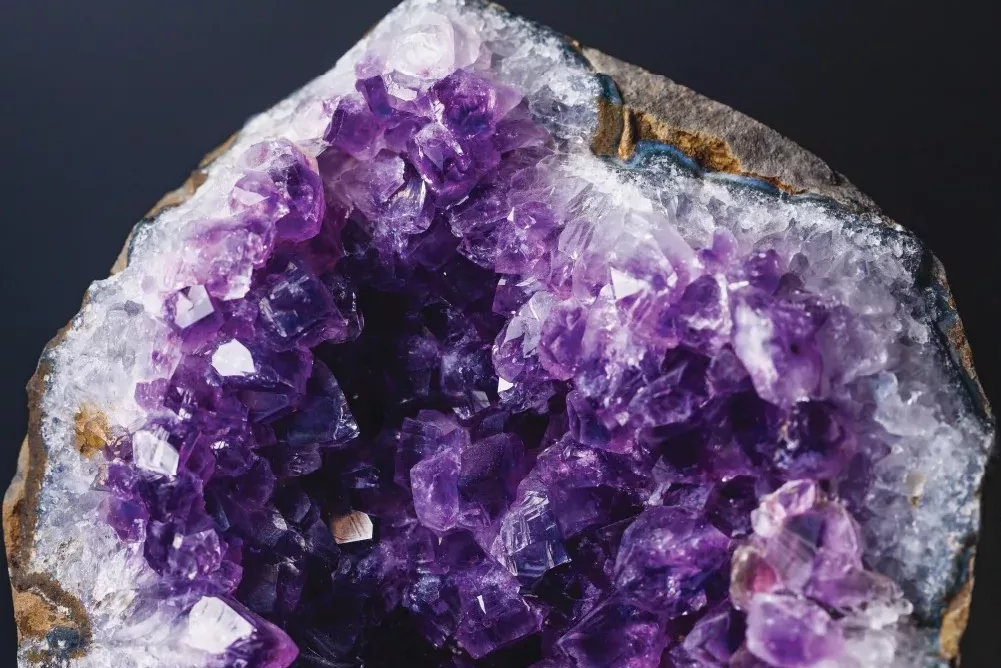
February is a month known for its cool and crisp weather and is also a special time for those born in this month as they are associated with the stunning and captivating Amethyst birthstone. Amethyst is a beautiful purple gemstone that is prized for its color, durability, and historical significance.
Amethyst is a type of quartz, and its unique purple hue is due to the presence of iron and other trace elements within the mineral. This color can range from pale lilac to a deep, rich purple and can sometimes exhibit flashes of red or blue. The ancient Greeks believed that amethyst had mystical powers and could protect the wearer from drunkenness and other vices. The word “amethyst” is derived from the Greek word “amethustos,” which means “not drunken.” This belief in the stone’s powers led to it being highly valued and used in jewelry and other decorative items.
Amethyst has a long and rich history dating back thousands of years. The ancient Greeks and Romans believed that amethyst had mystical powers and could protect the wearer from drunkenness and other vices. The ancient Greeks would often carve images of wine goblets into amethyst to symbolize their belief in the stone’s ability to prevent drunkenness. Amethyst was also believed to have healing powers and was often used to treat ailments such as insomnia, headaches, and digestive problems.
In the ancient world, amethyst was a highly valued stone and was often used in jewelry, religious artifacts, and other decorative items. The ancient Egyptians believed that amethyst had the power to protect against evil spirits and was often buried with amethyst jewelry. The ancient Romans also valued amethyst and used it to make engraved signet rings that were used to seal important documents.
In the Middle Ages, amethyst was believed to have spiritual significance and was often used in rosaries, religious figurines, and other religious artifacts. During this time, it was also believed that amethyst could enhance intuition, spiritual awareness, and inner peace. The stone’s association with spirituality and purity also made it a popular choice for bishops’ rings and other religious items.
Amethyst’s popularity continued into the Renaissance when it was highly sought after by royalty and the wealthy for its beauty and rarity. During this time, the deep, rich purple color of amethyst was particularly prized, and the stone was often set in gold and other precious metals. Today, amethyst is still a popular choice for jewelry, as well as for other decorative items such as paperweights, figurines, and other objects. It is also used in alternative healing practices and is believed to have properties that can help balance the mind and body.
Aside from its cultural and historical significance, amethyst is also popular for its durability. This makes it an ideal choice for jewelry and other items that are subject to daily wear and tear. Amethyst is also a relatively hard stone, ranking a 7 on the Mohs scale of mineral hardness, which means it can withstand scratches and other types of damage that might occur from regular wear.
In addition to its durability, amethyst is also an affordable option compared to other gemstones like diamonds or rubies. This, combined with its stunning beauty, makes it an ideal choice for those looking for a special piece of jewelry to celebrate a February birth. Whether it’s a ring, pendant, or pair of earrings, an amethyst birthstone is a timeless piece that can be treasured for a lifetime.
In conclusion, the amethyst birthstone is a beautiful, affordable, and durable choice for those born in February. It has a rich and fascinating history dating back thousands of years. From the ancient Greeks and Romans to the Middle Ages and the Renaissance, amethyst has been prized for its beauty, rarity, and mystical powers. Its unique purple hue makes it a stunning addition to any jewelry collection. Whether it’s for personal use or as a gift, an amethyst birthstone is sure to bring joy and happiness to its wearer for years to come.